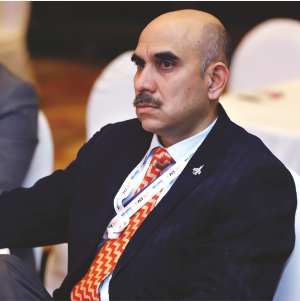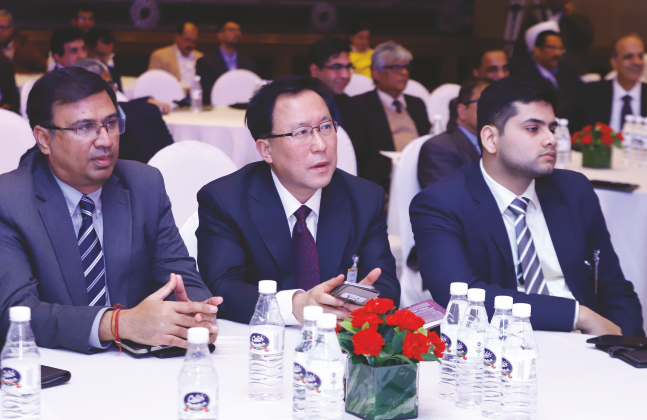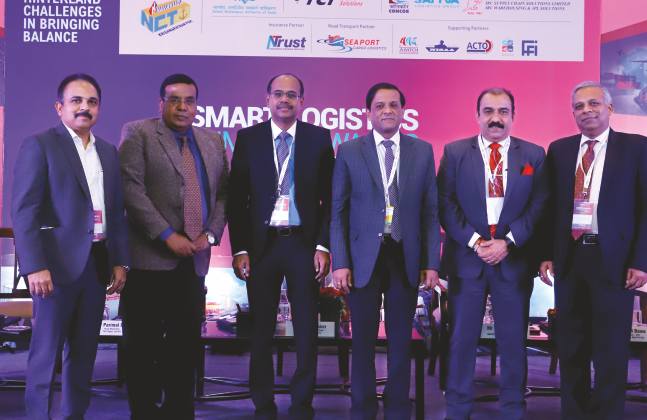Issues related to time and cost efficiency of logistics were discussed taking in context various modes of transport
Anil Radhakrishnan, Founder, Accex Supply Chain & Warehousing Pvt Ltd moderated the second session with theme statement ‘Cargo Movement Challenges for NCR.’ Different speakers voiced their opinions on the challenges.
Jaibhasker, Delivery Manager, North India, Maerskline India Pvt Ltd, kicked off by saying that capacity has enabled containerized shipments to reach the destinations within 4 days from the date of landing at the ports of Mundra or Pipavav. However there were also occasions when the transit times were as high as 29 days.
An end user, a businessman, Parimal Das, DGM Logistics, TDT Copper Ltd said that cost was not the only factor to be considered. An equally important factor was time. To highlight the importance of time, he said that the cost of his consignment was about `3 crores and the daily interest on this consignment was Rs 3000. Further he said, addressing to the operators, it does not help him when they expressed their helplessness when situations went awry. He needed solutions and that was what he expected from them. He was not unduly concerned with the cost of the transportation, but was more perturbed with transit times. Everybody stood to benefit if time could be saved, Das reiterated.
He said that the number of documents required in some countries like China was half of what was required in India. In exports he felt that there was more room for improvement in documentation procedures. The other problem area was the holidays that tended to delay shipments, which was unnecessary. According to Das road improvement had certainly improved. Further the procedure of sealing the container at their factory was a “wonder,” which enabled faster movement of cargo from their factory premises.
Dwelling on the challenges of the hinterland movement, Capt Viren M Bawa, Chief Executive Officer -CFS, CMA CGM Logistics Park Dadri Pvt Ltd, said that though the rail movement was cheaper, road movement was preferred by the exporters due to the certainty of movement – the certainty of beating the cutoff date for vessels. However he felt that that the gap advantage of road over rail was becoming thinner.
Further he said that the Customs permission of allowing the exporters to self seal the export containers had propelled the shift from rail to road. However he feels that the shift would be short lived because the road transportation is fraught with risks. As a terminal operator they offer security to their shipments and other benefits. He was of the opinion that the onetime permission of self sealing should be withdrawn and be made applicable for only one Customs location. Else, he felt that the procedure would be detrimental to the ICDs and CFSs in the NCR.
Technology has come to the roads making the road movement more efficient and favourable. What would be the impact wondered Radhakrishnan? He tossed the question to Jaibhaskar and Surajit Sarkar, Chief Operating Officer, DMICDC Logistics Data Services Limited, for their views.
Sarkar said that it all came down to time. Time was cost. Jaibhaskar said that the road offered reliability and predictability which the rail could not offer. The transit time to the ports in Gujarat was 2 to 3 days at most. With GPS there was now visibility on the roads. However if the cargo were to transit by rail there was no certainty as to which route it would take from the NCR region – the North Western Railway Route (NWR), or the double stack route or the electric route. “As an end user to my customer I do not know which route it will take,” said Jaibhasker. Though the rail was the preferred carrier the factors of flexibility, reliability and predictability gave the roads an edge over rail.
Jaibhaskar said that their global carriers, however preferred rail to road. In order to cater to their requirements they had tied up with CONCOR and other Container Train Operators (CTOs) to have dedicated trains in place. Block trains were used by many of their customers which had brought in reliability in the services.
Capt Bawa had a caveat to offer. The road transportation was good provided the transporters had their own fleet of trucks. It was an unorganised sector, with intermediaries and traders in between which brought uncertainty in road transportation.
Another development that had been happening was the consolidation of services by services providers by incorporating integrated service models. Radhakrishnan asked the panel if they preferred the integrated service or the silos structure?

Das emphatically approved of the integrated services of which he was the recipient for his cargo movement. He further went on to say he had imports from Japan again through a single agency. However he stressed that the value added information they shared with their customers was “phenomenal”. Likewise, he added that there should be some bench-marking against which we should also perform. Many of the activities did not require high technology and were within our means to adopt. Exports was going to rise substantially. The logistics sector will have immense opportunities to partake.
On this question Jaibhaskar stated that they too were looking at offering end to end services. Earlier in imports their services terminated at ICD Tughlakabad. But now they had extended it to the doors of their customers. The Bills of Lading were issued to sub cargo clusters such as Noida or Meerut.
“THOUGH THE RAIL MOVEMENT WAS CHEAPER, ROAD MOVEMENT WAS PREFERRED BY THE EXPORTERS DUE TO THE CERTAINTY OF MOVEMENT – THE CERTAINTY OF BEATING THE CUT-OFF DATE FOR VESSELS. HOWEVER THE GAP ADVANTAGE OF ROAD OVER RAIL WAS BECOMING THINNER.FURTHER, THE CUSTOMS PERMISSION OF ALLOWING THE EXPORTERS TO SELF SEAL THE EXPORT CONTAINERS HAD PROPELLED THE SHIFT FROM RAIL TO ROAD.”

An interesting question from the audience was how the inventory in the various locations in the NCR was managed when the exim movement was import heavy and export light? What would be the scenario when DFC became functional?
Jaibhaskar gave an interesting insight on the modus operandi followed by them. He explained in the context of the NCR which was 40’ import heavy and exports were predominantly through 20’ containers. In the NCR clusters, different locations had different dynamics. In the rainy season there were more requirements for 20’ containers in locations such as Sonipat and Karnal. In other location there would be more requirement for 40’.
It was necessary for the shipping lines to have good volume of imports which would obviate the costly necessity of re-positioning empty containers from the ports. Once the equipment was in the basket of NCR, they could then plan to distribute to the various locations in and around the NCR. The imbalance of containers had cost attached to it. Moving containers to a terminal in Gurgaon from Dadri which was 200 kms away had a substantial element of cost.
In a post DFC scenario, cargo may be consolidated in nodes like Dadri in UP or Kathuwas in Rajasthan which was on the DFC route and ipso facto have the efficiency of long haul costing. An exporter sitting in Panipat may then use Dadri to load his container to enjoy the benefit of long haul costing. The efficiency in costing would be in the long haul. The short hauls would start feeding into the long hauls so that end to end costing would reduce.







